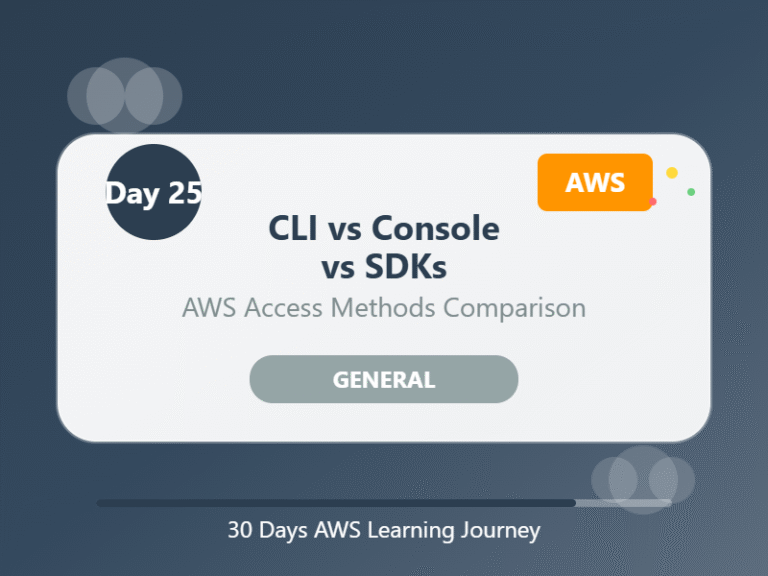⚙️ Day 25: CLI vs Console vs SDKs – How to Access AWS
Category: General / Tools
Goal: Understand the different ways you can interact with AWS and when to use each.
🧠 What You’ll Learn Today:
- What is the AWS Management Console?
- What is the AWS CLI?
- What are AWS SDKs?
- When to use which method?
🖱️ 1. AWS Management Console – Click and Configure
This is the web-based interface you use in a browser.
It’s visual and beginner-friendly.
✅ Best for:
- Learning how AWS services work
- Small tasks or demos
- Exploring new services
⛔️ Not ideal for:
- Repeating tasks
- Automating things
💻 2. AWS CLI – Command Line Interface
With the AWS CLI, you can run AWS commands from your terminal.
You install it on your system and configure it with access credentials.
✅ Best for:
- Automating tasks with scripts
- Working faster with repeatable actions
- Managing AWS infrastructure through commands
🔍 Example:

This lists all your S3 buckets.
💡 3. AWS SDKs – Code That Talks to AWS
SDKs (Software Development Kits) let you write code in your favorite language (Python, JavaScript, Java, etc.) to interact with AWS services.
✅ Best for:
- Building custom applications
- Automating AWS tasks in code
- Integrating AWS into web or mobile apps
🛠 Common SDKs:
- Boto3 for Python
- AWS SDK for JavaScript (v3)
- AWS SDK for Java, .NET, Go, etc.
🤔 Which One Should You Use?
| Scenario | Use This |
|---|---|
| Quick test or demo | Console |
| Repeating tasks or scripting | CLI |
| App integration or automation | SDK |
🧠 End of the Day Notes:
📌 AWS gives you multiple access options – choose based on what you’re doing.
🧑💻 Learn CLI for DevOps, SDKs for development, and use Console to explore.
🔁 Navigate the Series:
⬅️ Day 24: Build a Serverless App – No Servers, No Stress
➡️ Day 26: Shared Responsibility Model – Who Secures What?


